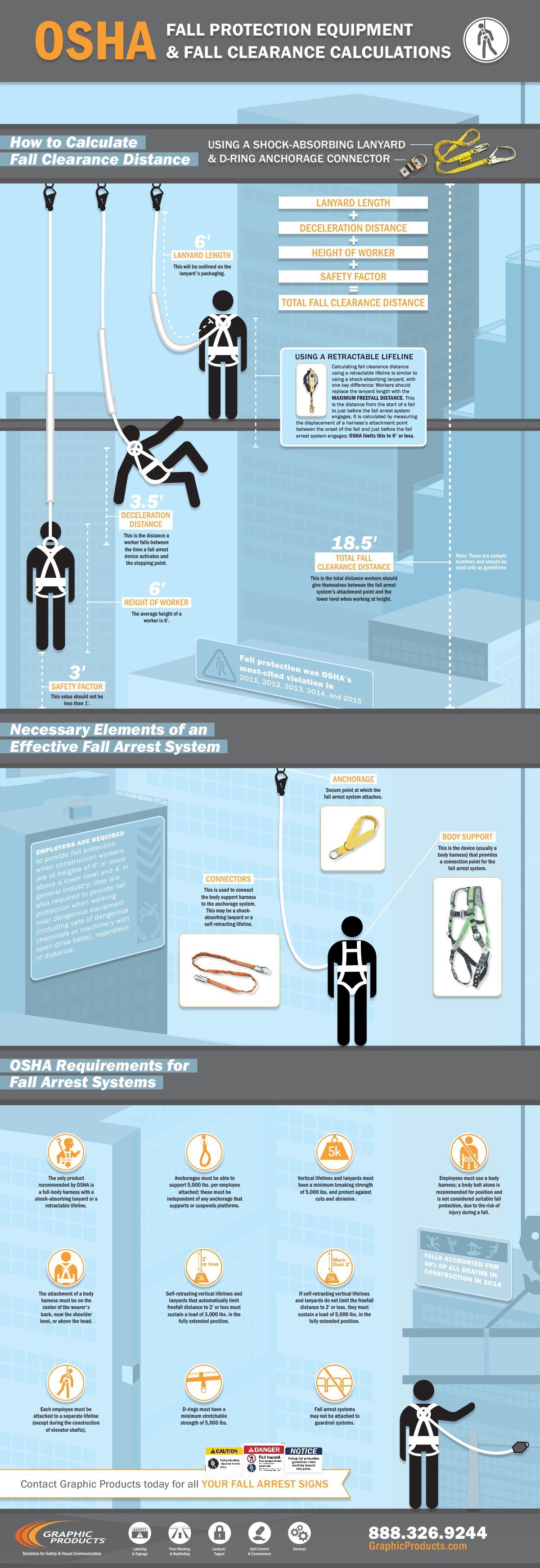- Home
- >
- Resources
- >
- Infographics
- >
- OSHA Fall Protection Equipment
Resource Navigation
OSHA Fall Protection Equipment
03
February,
2023
2 MINUTE READ
In 2014, 818 U.S. workers died from slips, trips, and falls-the highest such number in nearly a decade-and missing or ineffective fall protection has been OSHA's most-cited violation every year since 2011.
It doesn't have to be this way. Employers and qualified employees can work together to save lives and improve safety by understanding fall arrest systems and properly calculating fall clearance distance.
This informative infographic helps employers by breaking down fall clearance distance calculations, outlining the necessary elements of an effective fall arrest system, and explaining OSHA's fall arrest requirements.
How to Calculate Fall Clearance Distance
Using a shock-absorbing lanyard & D-ring anchorage connector:
Lanyard length + deceleration distance + height of worker + safety factor = Total fall clearance distance
6' lanyard length. This will be outlined on the lanyard's packaging.
Using a Retractable Lifeline:
Calculating fall clearance distance using a retractable lifeline is similar to using a shock-absorbing lanyard, with one key difference: Workers should replace the lanyard length with the maximum freefall distance. This is the distance from the start of a fall to just before the fall arrest system engages. It is calculated by measuring the displacement of harness's attachment point between the onset of the fall and just before the fall arrest system engages; OSHA limits this to 6' or less.
3.5' deceleration distance. This is the distance a worker falls between the time a fall arrest device activates and the stopping point.
6' height of worker. The average height of a worker is 6'.
3' safety factor. This value should not be less than 1'.
18.5' total fall clearance distance. This is the total distance workers should give themselves between the fall arrest system's attachment point and the lower level when working at height. Note: These are sample numbers and should be used only as guidelines.
Fall protection was OSHA's most-cited violation in 2011, 2012, 2013, 2014, and 2015.
Necessary Elements of an Effective Fall Arrest System
Employers are required to provide fall protection when construction workers are at heights of 6' or more above a lower level and 4' in general industry; they are also required to provide fall protection when working near dangerous equipment (including vats of dangerous chemicals or machinery with open drive belts), regardless of distance.
Anchorage: Secure point at which the fall arrest system attaches.
Connectors: This is used to connect the body support harness to the anchorage system. This may be a shock-absorbing lanyard or a self-retracting lifeline.
Body Support: This is the device (usually a body harness) that provides a connection point for the fall arrest system.
OSHA Requirements for Fall Arrest Systems
The only product recommended by OSHA is a full-body harness with a shock-absorbing lanyard or a retractable lifeline.
Anchorages must be able to support 5,000 lbs per employee attached; these must be independent of any anchorage supports or suspends platforms.
Vertical lifelines and lanyards must have a minimum breaking strength of 5,000 lbs and protect against cuts and abrasion.
Employees must use a body harness; a body belt alone is recommended for position and is not considered suitable fall protection, due to the risk of injury during a fall.
The attachment of a body harness must be on the center of the wearer's back, near the shoulder level, or above the head.
Self-retracting vertical lifelines and lanyards that automatically limit freefall distance to 2' or less must sustain a load of 3,000 lbs in the fully extended position.
If self-retracting vertical lifelines and lanyards do not limit the freefall distance to 2' or less, they must sustain a load of 5,000 lbs in the fully extended position.
Falls accounted for 40% of all deaths in construction in 2014.
Each employee must be attached to a separate lifeline (except during the construction of elevator shafts).
D-rings must have a minimum stretchable strength of 5,000 lbs
Fall arrest systems may not be attached to guardrail systems.
Contact DuraLabel today for all your FALL PROTECTION SAFETY NEEDS.
RELATED RESOURCES

OSHA Fall Protection Guidelines
Missing or ineffective fall protection is routinely OSHA's most common violation, and falls are the leading ...
Read
Top 10 OSHA Violations of 2020
Most Common OSHA Violations Each year, OSHA releases a list of the top 10 most cited workplace safety ...
Read
Construction Safety
Work dynamics in the construction industry are shifting more than ever due to increasing temporary and ...
Read.png)



